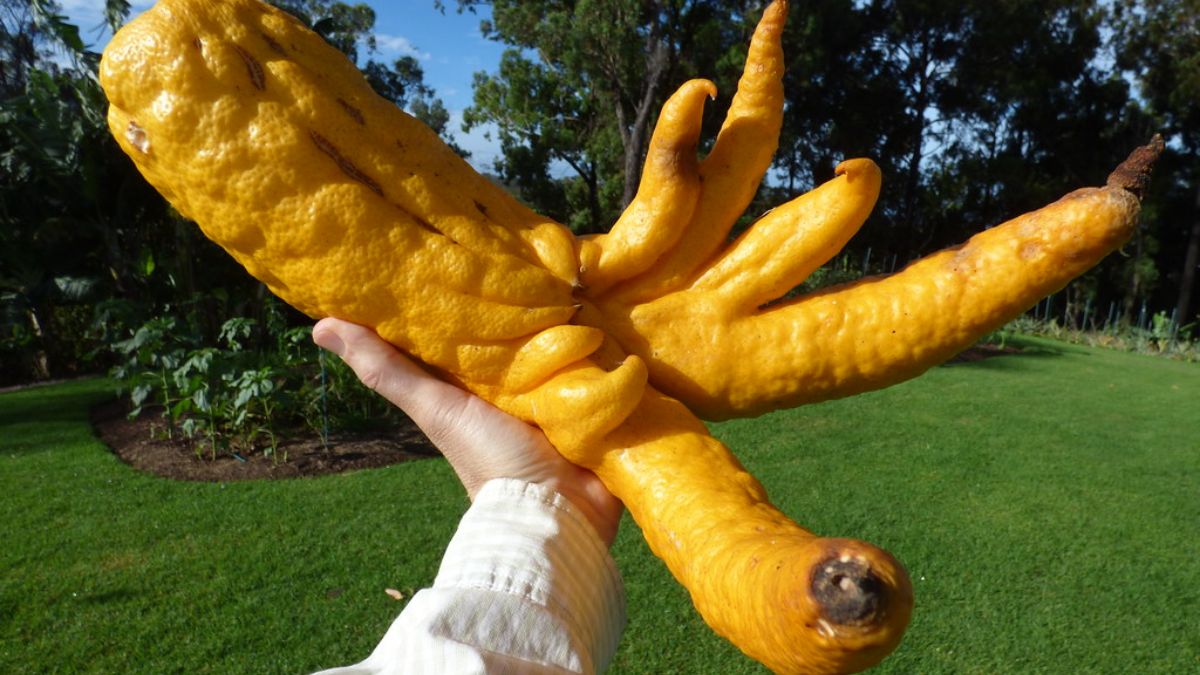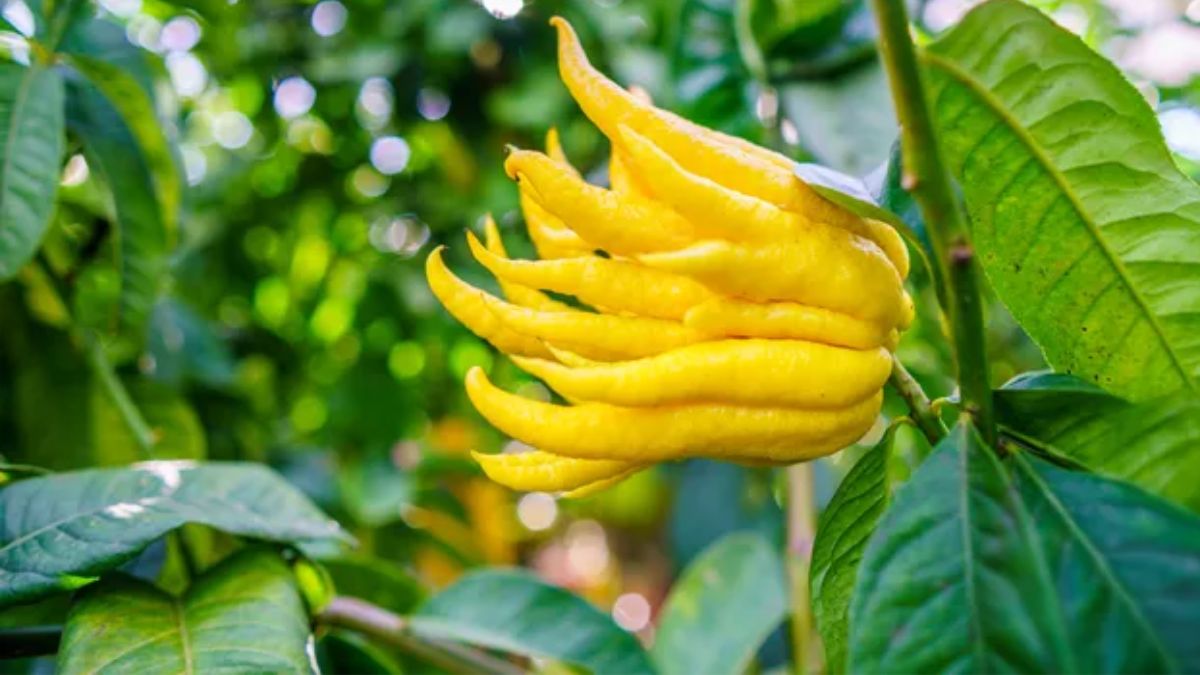Buddha’s hand is a citrus fruit belonging to the citron family that resembles a lemon and has long finger-like segments. It has no fruit or pulp, but the peel and rind are incredibly fragrant, and the peel and rind can be used in salad dressings, marinades, baked products, and drinks. Buddha’s hand has a nutritional profile similar to raw lemon peel, meaning that one teaspoon (2 grams) has minimal levels of protein, carbohydrates, lipids, and fiber and less than one calorie. A Buddha’s Hand Citron (var. sarcodactylis) looks and smells like a lumpy lemon with fingers. The citron, its parent, may have been brought to China from India by Buddhist monks and farmed near the Yangtze Valley in ancient China.
Buddha’s hand can relieve pain, soothe gastrointestinal discomfort, stimulate the immune system, reduce inflammation, ease menstruation difficulties, and lower blood pressure, and apparent respiratory infection, among other things. Buddha’s hand fruits begin with dark green skin and “closed” fingers, giving them a pear-like form. The dark green skin of the fruit turns bright yellow as it ripens, and the “fingers” of the fruit begin to open. When the Buddha’s hand is entirely yellow, it is fully ripe.
What is Buddha’s Hand?
Buddha’s hand, also known as fingered citron, is a citron cultivar, Citrus medica var. sarcodactylis, with no fruit, pulp, juice, or seeds. Its name comes from its unique shape, which resembles a hand with several splayed fingers, while some cultivars resemble a closed hand rather than an open one. While its insides are nothing more than bitter, white pith beneath its bright yellow peel, its zest gives a wonderful lemon blossom-like flavor to dishes and may be used in any recipe that asks for citrus zest. Its peel can be candied as well.
Fingered citron, like another citrus, requires a warm, or at least temperate, climate to thrive. Buddha’s hand can grow where lemons and oranges can. It also ripens and is harvested throughout the winter, like other citrus fruits, and may be available for purchase into the spring. It comes into season later than grapefruit and later than oranges, so it may be well into winter before you see it piled high at markets.
What are the Health Benefits of Buddha’s Hand?
Pain Relief: Buddha’s hand has been used for pain treatment for thousands of years, owing to the chemical composition of the fruit, which includes coumarin, limonin, and diosmin. Buddha’s hand can ease swelling and discomfort caused by accidents and surgeries to minor bangs and bruises. It is generally thought to hasten wound healing and bruise discolouration due to its anti-inflammatory properties.
Respiratory Issues: One of the most common applications of Buddha’s hand is to treat respiratory problems. Because Buddha’s hand is an expectorant, it might be a rapid and painless cure for excessive coughing that creates phlegm or catarrh. Before eating the fruit, soak it in a bowl with water and sugar to make it even more effective.
Gastrointestinal Issues: If you have a stomach ache, diarrhea, cramping, bloating, or constipation, Buddha’s hand can help. It reduces inflammation in the stomach lining and usually relaxes the intestinal muscles, allowing digestion and excretion.
Menstrual Discomfort: Buddha’s hand has long been used as a natural cure for women who have cumbersome menstrual cycles, including cramps, bleeding, and mood changes. The fruit’s anti-inflammatory properties and some of its other antioxidant properties make it an ideal remedy if you’re dealing with this unpleasant ailment.
Immune Health: A polysaccharide found in Buddha’s hand has been related to activating macrophage activity and improving the immune system’s quickness and efficacy. Although this is more of a preventative measure to keep your immune system strong, Buddha’s hand should also be eaten if you have a cold or flu since it can help you recover faster.
Blood Pressure: The alcohol extract from Buddha’s hand acts as a vasodilator, relaxing and dilating coronary blood vessels and improving circulation, effectively lowering blood pressure and minimizing the risk of atherosclerosis, heart attack, and stroke. This helps create a long-term healthy lifestyle by reducing the load on the cardiovascular system.
How did this Fruit Get its Name?
“Buddha’s hand” translates the fruit’s names into Cantonese, Mandarin, Japanese, Korean, and Vietnamese. It has traditionally been used as a Buddhist temple offering, particularly the close-fingered forms that mimic a praying hand stance. The fruit represents joy, longevity, and good fortune, and the fruit is displayed for good luck in China. Buddha’s hand is a traditional New Year’s gift in Japan to symbolize good fortune.
How to Use Buddha’s Hand?
Buddha’s hand, like other citrons, is mainly utilized for its zest and peel. Most fingered citron cultivars lack any fruit or pulp to eat, either within the peel-covered fingers or within the fruit’s base. Break off a “finger” from Buddha’s hand and grate or peel the brilliant lemon exterior. You want the brightly coloured section of the citrus peel, not the bitter white pith beneath.
Use the shredded zest in baked goods, salad dressings, beverages, marinades, and other dishes and recipes that call for lemon or orange zest. It’s worth noting that the aroma is potent and lovely and fragrant but powerful and dense. In any recipe, a little goes a long way.
What does it Taste like?
You’re more likely to notice its aroma than its flavour because you don’t eat the zest but instead add it in small amounts to various dishes. It has a solid sweet and citrus scent. The white pith beneath the rind is generally bitter but with a minor sweetness, at least when compared to the pith of other citrus fruits, and is slightly crunchy. The buddha’s hand fruit has an incredible flavour that tastes like citron mixed with lemon and yuzu, and it’s surprisingly simple to make! Buddha’s hand is also known as the fingered citron because of its distinctive shape, mimicking fingers and hands in a prayer position.
Where to Buy Buddha’s Hand?
Buddha’s hand is accessible at Asian markets and specialized food stores like Whole Foods and traditional supermarkets during the late fall and winter months. Pick ones with firm, deep peels and a noticeable floral-lemon smell. Any fruit with soft areas or feeble fingers should be avoided. This advice only applies some of the time because there are both “open-fingered” and “close-fingered” varieties. Still, most Buddha hands sold in the United States are the “open-fingered” type, which should have fingers that are clearly separated and curling away from each other, as this is what they do when the fruit is ripe.
Conclusion
This curiously called fruit may be unfamiliar to you, which is understandable given its limited range and the small amount of fruit that can be ingested from each one. Citrus medieval is its scientific name. This citron variety (like pomelos and mandarins) is called Sarcodactylis because the fruit is divided into long, thin portions that resemble human fingers. Buddha’s hand is native to India or China like other citron types. It has long been employed in religious rites, presumably due to the Buddhist faith’s prominence of Buddha’s open hand. However, because of its sweet, citrusy scent, this fruit is often utilized in perfumes and can be ingested for therapeutic purposes.

